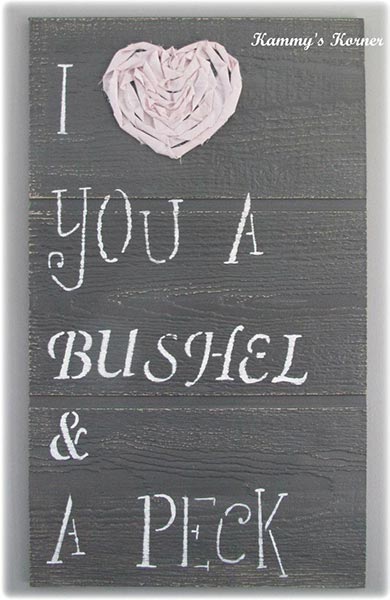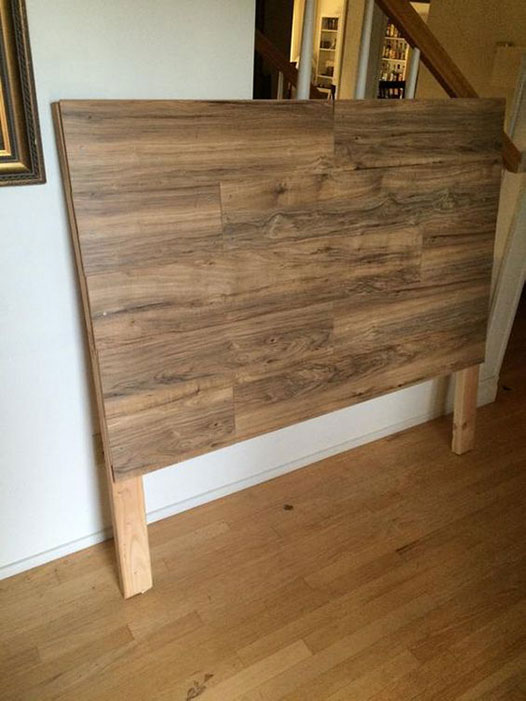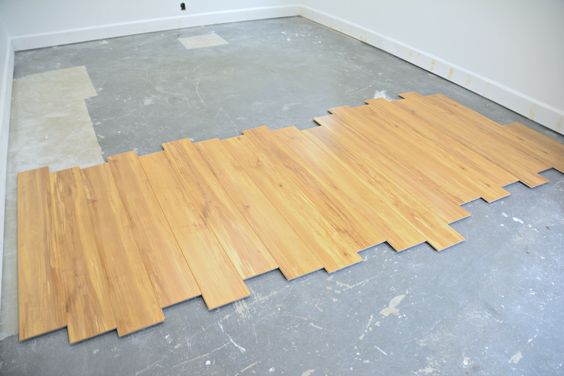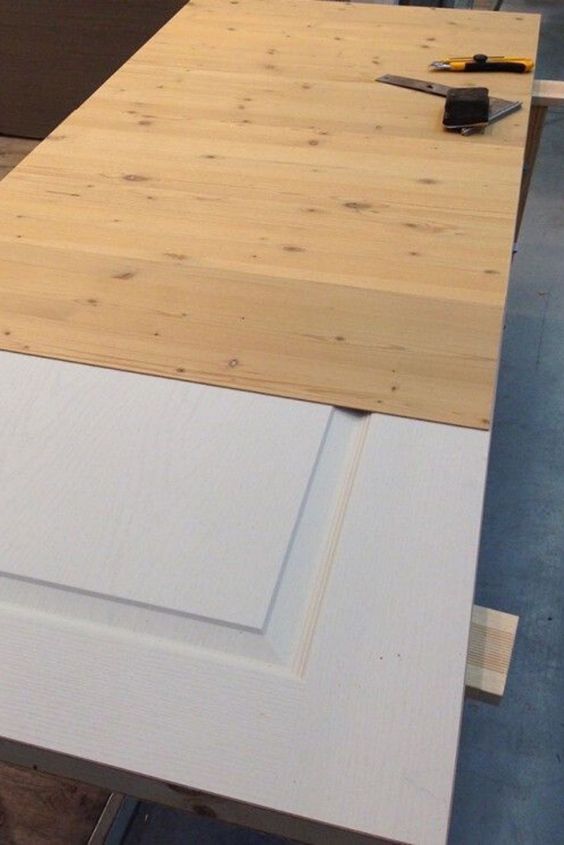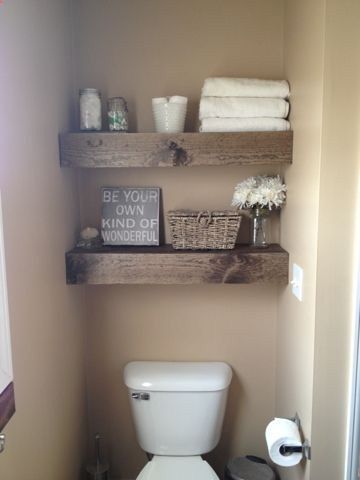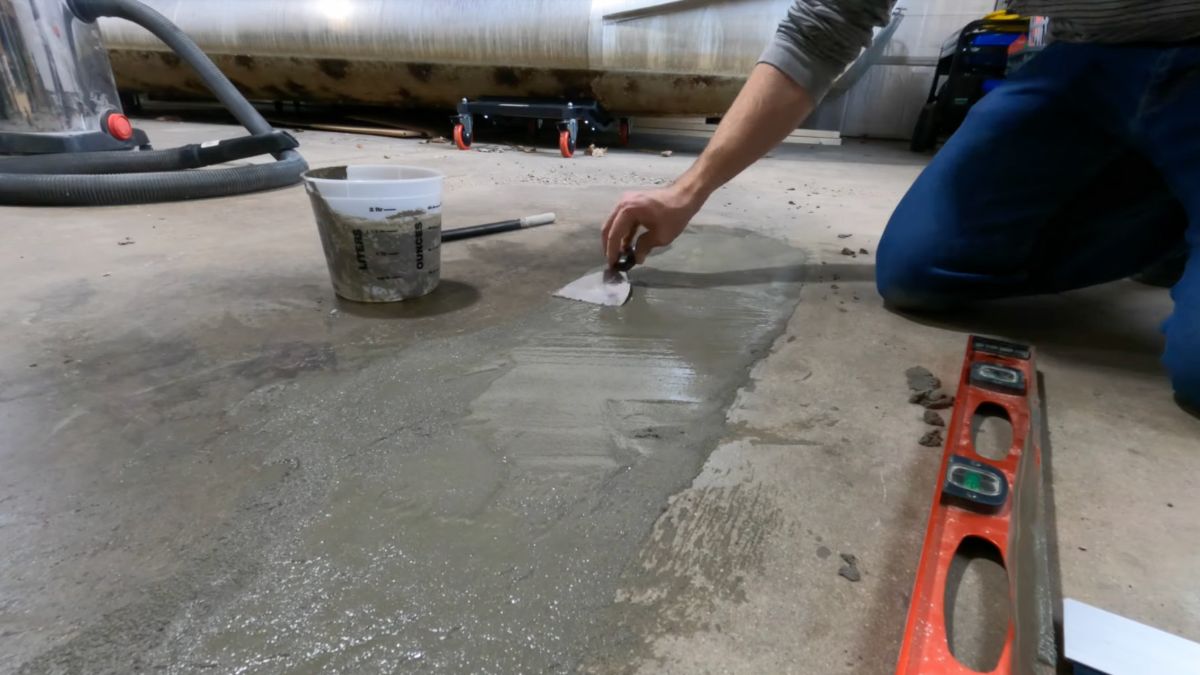
Often when you get new laminate flooring, you will have some leftover laminate flooring material. Maybe you installed a new floor and now have all your old leftover laminate flooring. You may be asking yourself, what can you do with it? How do I dispose of it? Can I repurpose it?
There is no designed way to dispose of old or leftover laminate flooring. You can store leftover laminate flooring in the event you need to replace damaged pieces later. If you have old or leftover laminate flooring, we suggest you donate it to a local salvage store, or you can repurpose it around your house.
It would be wise to understand the characteristics that make laminate flooring a popular choice to know how to use it. This article discusses those characteristics and provides some ideas you could use with leftover laminate.
Below are 21 things you can do with leftover laminate flooring.
1. Create s Unique Piece of Wall Art
You can create wall art using laminate using the leftover flooring as the base or one of the materials applied on a different base.
For example, when using laminate flooring as a base, you could paint images on it, spray paint through stencils, create calligraphic works of art, and include beautiful quotes, etc. If you don’t like the finish or color of your leftover laminate flooring, you can sand the surface and then paint it over with a different background color.
You can also use the decoupage technique to create art pieces. Typically, it entails sticking colored paper cutouts of different images onto a laminate flooring surface. But you can also use additional materials, such as fabric, ink, and gold leaf, to enhance the artwork.
You don’t have to be skilled at drawing, painting, or anything like that when it comes to this kind of art. You only have to have a great eye, the ability to create picture cutouts from existing images, and voila! Decoupage art is not only a great way of upcycling leftover laminate flooring but also reducing the number of old magazines you have in your home.
Other forms of wall art you can create using laminate flooring include entrance wall signs, wall hanging signs, collage pieces that use laminate as one of the materials, etc.
2. Welcome Friends and Family with a DIY Sign

Signs are trendy. You can create both vertical and horizontal signage for everyday use or holidays. Examples include:
- Welcome signs
- Last name signs
- Merry Christmas/Happy Holidays
- Happy Halloween
- Happy Easter
3. New Facelift to Old Furniture Pieces
It’s amazing how many ways you can redesign your furniture pieces using leftover laminate flooring.
If you have a work desk, dining table, gaming table, children’s play desk, or crafts table, you can breathe a new life into it by making it over using laminate flooring. You can also use laminate to create bench and chair tops.
When creating tabletops or desktops, you need to prepare your existing surface and glue the laminate flooring onto it. A utility knife or saw can help you cut the pieces, a clamp can hold the pieces onto the table, and a strong adhesive, such as wood glue, will help the flooring adhere to the wood.
Alternatively, you can create a custom desktop or tabletop by using plywood as a base, then gluing the laminate flooring on top. And if you like, you can paint over the laminate flooring to whichever color you prefer.
Other ways you can use laminate flooring include lining up your shoe rack, book, pantry, book, and closet shelves. You can also create shelves from scratch using leftover laminate flooring rather than materials like plywood. Doing so can make these furniture pieces look more exciting and reduce your DIY project costs.
4. Give Dull Walls an Modern Look With Waincoting

Wall treatments are things you apply or install on a wall to enhance its overall look and feel. If your walls tend to be boring, you can spice them up in various ways using leftover laminate floor pieces.
If you don’t have a lot of laminate pieces, you could consider installing wainscoting. These refer to panels homeowners install on the half lower parts of the walls of their homes.
Not only do they bring in an additional dimension into your space, thus making it look more attractive, but they also serve a functional purpose. Wainscoting helps safeguard your walls from spills, spatters, and scuff marks from furniture when it is moved.
Laminate flooring is easy to install as wainscoting because the planks easily lock together. But you may need to find other ways of ensuring the pieces continue to adhere to the wall, such as using finishing nails and strong adhesives.
5. Install an Accent Wall in a Half Bathroom (or any Room!)
Another way to use leftover laminate flooring is to create an accent wall. Typical accent walls tend to be different in color or design from other walls within a space. For this reason, they work as focal points and make the room more attractive.
When creating an accent wall, ensure your surface is smooth and clean. It must also be primed or painted.
During the installation process, you may also need to remove the trim or baseboards and cut off power in areas around the sockets and other electrical outlets. You will return these things when you are done. Another thing you should do is make sure the floor is level first, or your laminate flooring will end up tilting.
6. Make a Unique Bed Headboard
If you hate that panel currently behind your bed or don’t have one in the first place, you can use leftover laminate floors to create a headboard you are happy with. But to do so successfully, you should have a backing, which usually consists of plywood cut according to the size suited to your bed. After that, you can glue the laminate tiles and frame the entire headboard before fixing it onto the bed.
The beauty of making a headboard with laminate flooring is that you don’t have to use complete planks. You can use all the scrap pieces you have available to create interesting patterns onto the plywood base.
7. Give the Gift of Coasters (or Keep Them Yourself)
Coasters are probably one of the easiest things to create if you have leftover laminate floors. In this case, the essential tool is a cutting instrument, such as a circular saw. You can either leave them as they are or frame them. It all depends on your preferences.
8. Make a Cheap Mirror Look Like A Custom Piece

You probably look at yourself in the mirror every day? But do you like how it looks like? If it, you can redecorate your mirror using your leftover laminate floor pieces.
One way you can do that is by creating a mirror frame consisting of laminate pieces glued together. You can also use the same method to create picture frames. But you can also stick pieces of laminate onto an existing wood frame to make it more interesting.
9. Give Your Serving Tray a Makeover
Upcycling laminate flooring can help you recreate serving trays that serve as conversation pieces during any party you organize.
You can either glue laminate pieces onto the existing base or sides of the tray or remove the old base and create an entirely new one from laminate flooring. And to create contrast, you can paint some of the tray parts.
10. Cover Old Ugly Ceiling
If you don’t like the way your ceiling looks, you may want to install laminated planks to cover it up. You can also use your leftover laminate tiles to cover a botched repair job you don’t have enough money to fix right now.
When covering your ceiling with laminate, it’s always a good idea to draw lines to guide you during the installation process. And you must ensure you get the first row straight, or everything else will go wrong. It’s also worth noting that you may need to use screws or face nails for the first and last row to help secure the flooring up the ceiling. And if you want to hide them, the decorative molding will do.
11. Install Over an Attic Floor for More Storage
Whether you want to finish your attic to add living space or need a place to store totes and decoration, using old leftover laminate flooring is an option worth considering.
You’ll need to install a subfloor if your attic doesn’t already have one. Otherwise, you’ll need to install the laminate as normal. If finishing your attic for living space, you’ll want to use an underlayment pad. However, if you are using it for storage, you won’t need the padding.
Laminate is moisture and temperature-resistant. Therefore it can withstand the temperature swings of attic space.
12. Install Over Garage Floor for More Useful Space
Laminate flooring Is a durable product that does not rot and can withstand being installed in your garage because it’s moisture and temperature resistant.
If you use your garage for a purpose other than parking your car, the garage is also a great place to install leftover laminate flooring. Many people use their garages for additional living space such as a home office, exercise room, man-cave, entertaining, or a workshop.
If this is you, you can install old laminate flooring over the garage slab. You’ll want to install an underlayment padding underneath because laminate flooring over bare concrete can be loud when walked on. Installing laminate over a concrete slab is relatively easy as laminate is a click and snap product requiring no adhesives or nailing.
13. Install a Wall Organizer to Hang Coats (and Other Useful Things)
A wall organizer will enable you to get all those small items you tend to misplace or lose, such as your pair of scissors, favorite pair of earrings, and keys.
Typically, a large wall organizer consisting of laminate flooring leftovers will likely need another material as a backing, such as plywood. But smaller items may only need to be mounted on the wall. And depending on the design, you can also affix hanging hooks onto the wall organizer surface to enable it to function as a coat hanger.
14. Construct a Planter for a Vegetable Garden
Because laminate is not entirely waterproof, it will degrade with time when left in the outdoors. However, if you need temporary fencing to divide your garden into sections, you can use the laminate flooring planks for that. The perimeter you create around your vegetables, flowers, or bushes using this method can help improve the overall appearance of your garden.
You can also create markers for your garden plants using leftover laminate flooring.
In addition, you can use these pieces to develop temporary raised beds as you save up for sturdier materials to build more permanent ones. Alternatively, you can use laminate to block pallet crate holes when making raised garden beds.
15. Make an Office Chair Mat for a Home Office
If you only have a few pieces of leftover laminate flooring, consider using it for a home office chair mat. The problem with plastic chair mats is they wear out quickly and require replacement regularly.
Using laminate flooring as a chair mat, you can create a durable surface that lasts for years.
Depending on the width of the laminate flooring, you’ll need 8 to 10 pieces of laminate flooring. While gluing the joints is not required, you may want to glue them to prevent separation as your chair rolls across the surface.
You’ll need to apply a bead of glue along the locking joints as each piece of flooring is placed. Be sure to press the ends against a straight wall to ensure a straight edge. Wipe off the excess and allow to dry 24 hours before use.
16. Dress up an Interior Door
Use leftover laminate flooring to give an interior door a modern facelift. This option is more suited towards luxury vinyl planks (LVP) because they are thinner than standard laminate flooring. Using the thicker laminate flooring may cause your doors to not open and close properly due to the added thickness.
LVP is a durable product that is easy to clean and well-suited for this application because it is a vinyl product you’ll need to wipe it clean as needed.
You’ll need to clean the door surface thoroughly and use a construction adhesive like Liquid Nails to adhere the planks to the door surface. Use a brush to spread the adhesive evenly, and use a rubber roller across the plank surface to press the planks firmly in place.
Use a utility knife to score and trim off the excess and cut the opening for the door hardware.
17. Create Custom Picture Frames for Family Prints
Using leftover laminate flooring to make picture frames is a great way to bring some cohesiveness to your interior design.
You’ll need some carpentry skills because the planks will need to be cut precisely to size and at 45-degree angles to form the corners. If you don’t have the tools to do this, you can ask a friend or family member to help you.
You can use the glass in the existing frame as a measuring guide since you’ll be reusing the glass.
18. Make a Durable Workbench Top
You can use leftover laminate planks to cover a workbench in a garage or workshop. The laminate creates a durable, easy-to-clean top that mimics Formica in many ways.
You can apply the planks straight across the top or stagger the planks for a custom look. You’ll need to use construction adhesive to adhere the planks to the tabletop and prevent them from moving. Use a rubber roller across the top of the planks to ensure a firm bond. Apply weight on the planks until the adhesive dries.
If you don’t want to glue the planks down, you’ll need to use wood outside corner trim to hold the planks in place. Nail the corner trim in place with finishing nails.
19. Add More Storage With Wall Shelving
You can use leftover laminate flooring to build or cover existing shelving. You can use 2×2 wood or 2×4 wood framing to form the support for the laminate shelving.
You can also use laminate planks to lay directly over wire shelving in closets or pantries to provide a solid base to store small items that overwise don’t sit well on wire shelving. These items include spices, drinks, can goods, small box goods, etc.
20. Store Away Your Leftover Flooring (You May Need It)
When installing new laminate flooring, most contractors will buy extra materials. It’s a good idea to store these extra materials if some pieces become damaged and need to be replaced. The reason it’s a good idea to hold on to the remaining materials is because it would be nearly impossible to match the flooring later on if needed.
You can store the leftover laminate flooring in a closet, attic, or garage. If possible, store the materials in the original packaging to prevent the materials from getting scratched or otherwise damaged.
If the time arises that some of your floor planks are damaged, you can replace these boards relatively easily.
21. Help Someone by Donating to Local Salvage Store
When removing old laminate flooring, a good option to consider is donating the used flooring to a local salvage shop. Salvage shops sell reclaimed building materials to their patrons. By donating the flooring, another family can repurpose the materials and give them new life.
Donating the old flooring material is far better than them ending up in a landfill. Laminate flooring is generally considered eco-friendly. However, there is a significant drawback.
Laminate flooring doesn’t rot or easily break down as wood, and other building materials do. Laminate flooring that ends up in landfills can remain for hundreds of years. We encourage you to repurpose the flooring if there is any way possible.
Characteristics Of Laminate Flooring
If you are thinking of ways to repurpose laminate flooring, you should bear the following characteristics in mind.
1. Laminate Is Affordable
Laminate is one of the most cost-effective flooring products available. You can buy it for $0.70 and $2.00 per square foot. So, if you have a project that could benefit from additional materials and your budget is limited, using leftover laminate flooring as a substitute could save you money.
2. Laminate Is Easy To Install
Laminate flooring is quite popular with DIY homeowners because it is easy to install. You will not have to spend money on mortar, grout, or adhesives. So long as there is a rigid and smooth underlayment, such as plywood or foam sheeting, you will have an easy time installing it. And with simple tools like a utility knife, handsaw, hammer, or rubber mallet, you can get things done quickly.
Due to laminate flooring’s ease of installation, you can use it on projects where you may not want to buy additional materials like mortar. Also, you can use the leftover flooring in DIY projects that require cutting and hammering.
3. Laminate Is Durable
Typically, laminate flooring can last anywhere from 15 to 25 years. Some products may last a little bit less or longer than that. That implies that you can use leftover laminate to create items you want to stay for a long time. You don’t need to worry that the leftover flooring will fall apart quickly.
One aspect of laminate that makes it durable is its strength. It withstands scratches, impact, and wear and tear pretty well. That makes it an excellent choice for anything that involves lots of foot traffic, children, and pets. It also works great in areas where there is heavy furniture. Therefore, you can reuse it in DIY projects where these things will be present.
4. Laminate Is Eco-Friendly
If you are concerned about the impact of your actions on the environment, then it makes sense to upcycle leftover laminate flooring.
Generally, laminate is usually manufactured without the use of dangerous heavy metals or pesticides. And it is made of recycled natural materials, such as wood, sawdust, wood chips, etc. Where wood is used, it tends to come from sustainably harvested forests.
And because it does not need gluing during installation, it is free from volatile organic compounds (VOCs). In addition, it does not require any special cleaning agents, thus removing the chances of using harmful chemicals.
Also, the way laminate flooring is made and installed makes it an excellent choice for people with allergies or diseases like asthma. So, you can create art or craft pieces and gift them to such people without worrying about how you will affect their health. In addition, you can use leftover laminate flooring to create artistic works that pass on an environmentally friendly message without feeling guilty.
5. Laminate Is Low Maintenance
Laminate’s low-maintenance feature is another attractive aspect of the flooring product. It is pretty resistant to stains and, thus, easy to clean without requiring complex cleaning tools like steam cleaners. Also, it does not fade even when exposed to sunlight for long periods.
In addition, it is a little bit moisture resistant, which makes it able to withstand quick spills. However, it would help if you cleaned the spills quickly because it is not entirely water-resistant. Thus, you cannot install it in areas where it will undergo prolonged exposure to water. So, that also means painting becomes tricky, though it is doable.
Therefore, if you are thinking of upcycling your leftover laminate flooring, you can use it for outdoor projects, provided the area the item is placed will remain dry. You can also use it to make items that may be exposed to sunlight for long periods.
6. Laminate Offers Design Variety
Another important laminate characteristic is that it offers design variety because the flooring product has come a long way and offers multiple looks and finishes. As a result, some products can stimulate the natural stone look while others mimic the wood look.
Laminates also offer various colors and finishes. Some are shiny, while others are not. Also, some laminate flooring products have a textured effect. In addition, the sizes also vary. And depending on your preferences, you can get them in the form of sheets, boards, or panels.
It’s worth noting, though, that laminate cannot undergo refinishing like wood.
Final Thoughts
Laminate flooring is a versatile material. If you find yourself dealing with leftover laminate flooring, put on your creative hat, and find a way to upcycle the pieces you have left. Doing so will help save the environment and money at the same time. So, do not let it go to waste.


